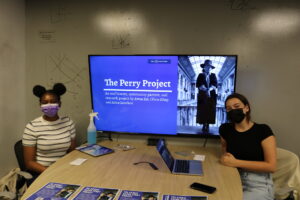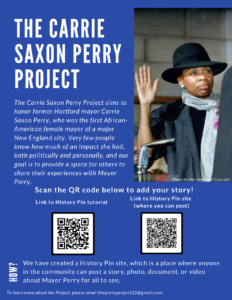The Carrie Saxon Perry Project: Honoring Hartford’s First African American Woman Elected Mayor
In September 2021, my Community Action Gateway group looked up the name “Carrie Saxon Perry” in Google. We found few results. Former Hartford Mayor Carrie Saxon Perry was a crucial trailblazer as the first Black woman elected mayor of a major New England city. But her leadership has not received the attention it deserves. After a year of studying and highlighting Mayor Perry’s legacy, we looked up her name again. A lot has changed and I urge you to Google her name yourself and find out. In collaboration with teacher Desiree Primus of S.A.N.D. School in Hartford, our group collected oral history interviews and other resources about Mayor Perry’s life, which were used to create a digital archive, History Pin website, and a presentation to Hartford school children.

The Carrie Saxon Perry Project aims to highlight and preserve the achievements and legacy of Mayor Perry, who served as Hartford’s mayor from 1987-1993. Desiree Primus created this project with the goal of sharing Perry’s legacy with the world, and especially the Hartford community. Desiree recognized the groundbreaking woman that Mayor Perry was, and that she had very little recognition in the media or in any kind of archive. As a school teacher, Desiree hoped the story of Mayor Perry could help inspire young people in Hartford. The Perry Project is particularly relevant to S.A.N.D. School because the school was built on the same land as the apartments Mayor Perry grew up in.
Along with Aisha Carothers ‘25 and Amna Zeb ’25, I started working on the Perry Project in my first weeks at Trinity College. During the fall semester, Desiree asked us to create a one-minute video about Carrie Saxon Perry to be shared with her class and posted online. We interviewed people like Lew Brown and Bruce Rubenstein, who worked with Mayor Perry, as well as Desiree. We learned that Perry grew up in Hartford with her mother and grandmother in the Bellevue Square community. She loved Hartford as a child, and even more as an adult. Mayor Perry had political intelligence and didn’t put up with being pushed around by other people in power. Through all the meetings, decisions, speeches, and hardship, she always carried herself with style and grace.
After our initial introduction to Mayor Perry’s extraordinary life, my group and I were lucky to continue this partnership into the spring semester. We expanded on the first semester’s work by creating a digital archive to preserve Mayor Perry’s legacy. We landed on four main goals for the second semester: continuing oral history collection; completing an archival scan and identifying documents to place in Trinity’s digital repository for the Project; creating a History Pin collection and corresponding Google Drive; and presenting to Desiree’s 5th grade students about Mayor Perry. All of these projects were fairly overwhelming when combined, but each held significance for the overall project.
 With the continuation of collecting oral histories of people close to Mayor Perry, we were able to form a network to support the Project and hear many personal, powerful anecdotes that simply could not be found in a Hartford Courant article or City Hall documents. Collecting these interviews helped us understand how important primary sources like these first-person accounts are to future researchers. What we gathered in these interviews we would have never found in scholarly articles or newspaper articles, yet they hold incredible importance when preserving memories of Mayor Perry.
With the continuation of collecting oral histories of people close to Mayor Perry, we were able to form a network to support the Project and hear many personal, powerful anecdotes that simply could not be found in a Hartford Courant article or City Hall documents. Collecting these interviews helped us understand how important primary sources like these first-person accounts are to future researchers. What we gathered in these interviews we would have never found in scholarly articles or newspaper articles, yet they hold incredible importance when preserving memories of Mayor Perry.
My classmate Amna Zeb ‘25 reflected: “Through the experiences provided by this year-long project, I mainly learned how to depend on and work successfully within a team to complete tasks. Listening to the ideas we each brought to the table and playing to each other’s strengths contributed heavily to the outcome of the project.” This was part of the beauty of this project: not only were we focused on those outcomes, but also the process that brought us to those outcomes. We came to realize this was a cornerstone of a mutually-beneficial community partnership, where we worked to make a powerful journey, not just an end destination.
Conducting an archival scan allowed us to consolidate all the existing documents relating to Mayor Perry. This also helped us to take inventory of what information was already out there and where we needed to fill the gaps. Once we gathered these documents, with the help of Mary Mahoney, Digital Scholarship Coordinator, and Amy Harrell, Educational Technology Librarian, we created a space in the Trinity Digital Repository for these items. This created an end-destination for all things Carrie Saxon Perry, which didn’t exist before.
We chose to use the platform History Pin to make a public, user-friendly collection about Carrie Saxon Perry that includes text, photo, video, and audio files. History Pin allows anyone who has the collection link to add a post. This way, if there are people in the community who have stories to share about Mayor Perry, they can add them directly to the collection. Additionally, History Pin is accessible and user-friendly, making it easy to pass on the account to future project contributors.
Finally, we created a presentation about Mayor Perry and had the privilege to visit S.A.N.D. School one rainy afternoon to speak to Desiree’s students. We were excited and a bit nervous. We wanted to impress the kids just as much as we wanted to impress the adults. After being greeted with balloons, a handmade poster board, and lots of 5th grade smiles, we talked to the students about everything we had learned about Mayor Perry in the last few months.

“The 5th grade students had a great time learning about the first Black female mayor in New England, who grew up in their neighborhood,” said Desiree. “Students were also delighted to ask questions about Trinity College and college in general because their knowledge about college comes mostly from TV. Many would be considered first generation college students if they opt to pursue their education after high school.”
The students were incredibly receptive, and on the ride home, Aisha, Amna and I chatted about how we already wanted to go back to S.A.N.D. School and connect with the kids even more. Meeting Desiree’s students had been a long time coming, and when the presentation in early April rolled around, we realized how important that facet of our project was.
“Many of the interviews and research components of the project took a lot of time and commitment, so we were not able to do as much work with Desiree’s students as we originally had planned,” said Aisha Carothers ‘25. “Finally being able to give her students an engaging and insightful presentation about Mayor Carrie Saxon Perry was incredibly impactful. Not only were the students ready to hear our presentation, but they were excited to share with us what they knew about Mayor Perry.”
After reflecting on the Carrie Saxon Perry Project in the summer, I believe perhaps the presentation to those students is the most important part. Our interviews with incredible figures such as Hartford artist Ellis Echevarria and historian and activist Steve Thornton left us in awe of Perry’s presence. The archival scan opened our eyes to information that wasn’t on the surface of the internet. Thanks to our work, many more search results pop up when you search “Carrie Saxon Perry.” But, when I think back to that original conversation with Desiree in September, what comes up most is sharing these resources with Hartford youth.

Our job for the Perry Project wasn’t just to bring justice to her name and legacy. Or just to have more Carrie Saxon Perry search results pop up. Our goal, which is reflected in our presentation, was to create and inspire more Carrie Saxon Perrys in the world. Thanks to Desiree and our work on the Carrie Saxon Perry Project, there is at least one more room full of students who know about the opportunities for leadership that Mayor Perry represents. As Lew Brown stated, “There are many more Carrie Saxon Perrys out there. That’s what keeps me going.”
To learn more about the Carrie Saxon Perry Project, email [email protected]
To contribute to or visit Mayor Perry’s History Pin site, view the History Pin tutorial here and visit the Mayor Perry site here.
In the Community Action Gateway, first-year students learn how to create community change with community activists, neighborhood organizers, government leaders, non-profit directors, journalists, and social entrepreneurs in Hartford. If you have questions about the Gateway, contact Director of Community Learning [email protected]
